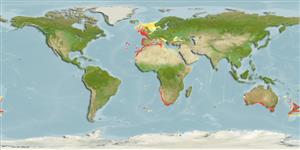Classificação / Names
Common names from other countries
Referência principal
Tamanho / Peso / Idade
Max length : 210 cm TL macho/indeterminado; (Ref. 36731); common length : 117 cm SL macho/indeterminado; (Ref. 6181); Peso máx. publicado: 8.0 kg (Ref. 6181)
Length at first maturity
Lm ?, range 92 - ? cm
Ambiente
; marinhas bentopelágico; oceanódromo (Ref. 51243); intervalo de profundidade 42 - 620 m (Ref. 56504), usually 100 - 300 m (Ref. 6181)
Clima / Intervalo
Deep-water, preferred 24°C (Ref. 107945); 64°N - 49°S, 29°W - 176°W (Ref. 6181)
Distribuição
Eastern Atlantic: France and western Mediterranean to Senegal, including Azores, Madeira, the Canary Islands and offshore seamounts; Cape Fria, Namibia to Agulhas Bank, South Africa including northern Walvis Ridge. Southern Indian Ocean: seamounts 30 to 35°S. Southwest Pacific: Australia (New South Wales to southern West Australia) and New Zealand. Southeast Pacific: Peru. A doubtful record from Cape San Lucas, Mexico.
Países | Áreas FAO | Ecossistemas | Ocorrências | Introduções
Descrição breve
Raios dorsais moles (total): 98-110; Espinhos anais 2; Raios anais moles: 59 - 66; Vértebras: 105 - 114. Second anal-fin spine plate-like. Pyloric caeca 20 - 29. Body uniformly silvery (Ref. 6181). Pelvic fin very small (Ref. 35388).
Categoria na Lista Vermelha da IUCN (Ref. 115185)
Ameaça para o homem
Harmless
Utilização humana
Pescarias: altamente comercial; peixe desportivo: sim
Mais informação
ColaboradoresFotografiasStamps, CoinsSonsCiguateraVelocidadeTipo de nataçãoÁrea branquialOutras referênciasCérebrosVisão
Ferramentas
Relatórios especiais
Descarregue XML
Fontes da internet
Estimates of some properties based on models
Phylogenetic diversity index
PD50 = 0.5156 many relatives (e.g. carps) 0.5 - 2.0 few relatives (e.g. lungfishes)
Nível Trófico
3.8 ±0.3 se; Based on diet studies.
Resiliência
Médio, tempo mínimo de duplicação da população 1,4 - 4,4 anos (K=0.06-0.3; tmax=7)
Vulnerabilidade
Moderate to high vulnerability (53 of 100)
Categoria de preço
